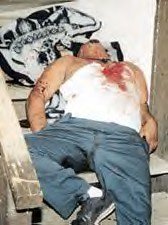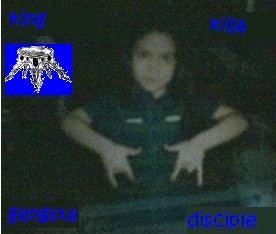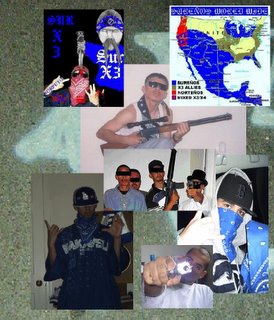Gang / Deviant Group Evolution:
The evolution in gang structure over the past 30 years in the United States has definitively changed the way law enforcement, community groups, and the general public must look at gangs and similar deviant groups.
 The following is excerpted from my book, Gang Related: Intelligence gathering, assessment, and profiling of street gang dynamics
The following is excerpted from my book, Gang Related: Intelligence gathering, assessment, and profiling of street gang dynamicsReproduction is prohibited without proper citation.
Networking of gang culture from urban / ghetto neighborhoods into the suburban and rural communities.
With the publication of Dan Korem’s Suburban Gangs, information began to come to the forefront of public knowledge about the change in gang dynamics. According to Korem and numerous other gang researchers the proliferation of gangs from inner city areas to suburban and finally rural areas of the United States gives us a more definitive understanding of why gangs form. Aside from the desire for youth to have a sense of structure, love, discipline, and social acceptance other factors also appear to have contributed to gang growth in various places.
Stories of gang “recruiters” marketing the gang lifestyle to youth in smaller cities and towns during the summer months when children are out of school continue to surface among gang involved youth. These gang “missionaries” have been reported to go as far as passing out literature seeking to recruit at risk youth into the culture thereby helping to establish a franchise type marketing of drugs and other illegal activities across the country.
While most gangs are reported to lack a hierarchy type of structure there is some evidence to support that some Nation or Super gang groups like the Gangster Disciples communicate and network with smaller cells of individuals throughout the United States. Though this is a rare structure the implications are startling nonetheless.
The greatest external component of gang proliferation (the catalyst for gang growth outside of internal needs such as family and love) appears to be simple migration of gang involved youth from large cities into more rural areas. These youth and young adults may leave the big city as minor players in their gang but come to smaller communities and form a hybridized version of their original gang where they can play greater leadership roles. The reasons the gang involved individuals leave their home cities are varied and range from escape from prosecution to simple migration with family members.
This movement of gang activity into smaller communities continues to foster the misguided belief that all gang activity outside of the “ghetto” of the big city is “wannabe” activity. However, in most instances those who are not qualified to make judgment calls on gang legitimacy are often in positions of authority. It is this lack of inaction and denial that creates a more fertile environment for dangerous gang growth. A key thought to keep in mind is this: In the 1960’s the Crips formed in Los Angles as a small group who were likely considered “wannabes” but now left unchecked for far too long have chapters across the United States and are reportedly even in Europe. New Orleans, Louisiana once had a “wannabe” gang atmosphere but when the power went out during Hurricane Katrina it was then that the real threat of unchecked gang activity came to the forefront in the form of armed guerillas controlling the city for nearly a week.
Recruitment of middle and upper class youth into gang culture.
Further clarifying the root causes of gang proliferation, the active involvement of youth in higher economic strata also illustrates that gangs do not form and grow primarily due to poverty or perceived oppression. In my lectures I have referred to this as the Lord of the Flies Syndrome. As in the classic story youth left with no reliable adult leadership and guidance will form their own social groups as a means of protection, support, love, kinship, and means of control. This natural human tendency to form social groups becomes dangerous when proper role models and love driven guidance is no longer available. Youth in all economic conditions share similar characteristics in that the lack of involvement or simple presence of family members causes an emotional vacuum to form, one in which terrible things can move into and forever change the youth towards a life of deviancy.
Conglomeration of local groups into more organized nation wide nation gangs.
Another social element of the human race is that we find familiarity in others and bond with it. This is truer when faced with a threat than with any other catalyst. The Nation gangs commonly referred to as People and Folks are loosely related superstructures of gang groups who generally gravitate towards one another because of common and shared symbols, colors, ideology, and folklore. These conglomerate groups do not always work together and there is occasionally infighting among groups with the same name. However the tendency towards larger and larger cooperative groups appears to be a reoccurring theme that also may have more dangerous implications in the future.
At the time of this writing a general movement within some Hispanic gangs into similar groupings appears to be taking place as well. One such grouping appears to indicate that groups such as the Mexican Mafia (a conglomeration of smaller groups itself); Mara Salvatrucha, and other smaller gangs may be gradually aligning under a larger banner of Sur 13 also known as Surenos. I have personally witnessed Sur 13 graffiti in Central Mexico, despite that fact that its origins lie in Southern California. Overall there is much debate over how organized many of these Nation gangs are, the evidence indicates that at least peripherally some amalgamation is taking place cannot be ignored.
Movement towards religious symbols and religious like rhetoric in gang subculture.
Following in the footsteps of some Neo Nazi groups the use of religious symbols in gang culture serves more than one purpose. The most nefarious being that groups labeled as “religious organizations” are less likely to be investigated by law enforcement due to the legal implications. Gangs also use religious symbolism including the use of gang prayers and creeds to further create a sense of comfort and familiarity with recruited youth. A young person who grows up learning about Islam in the home may not be as afraid to join a gang that overtly uses Islamic imagery in its graffiti. By the same token a youth that grows up hearing Bible stories about King David and the Israelites will be more likely to feel a sense of comfort with a gang such as the Gangster Disciples who call one of their founders King David along with using the 6 pointed star as their primary symbol.
The idea of “religion” fosters a sense of legitimacy which is now one of the cornerstones of gang indoctrination, that gangs are not gangs but legitimate organizations. Most gang involved youth will not answer “yes” to the question, “Are you a member of a gang?” because they are being taught that they are not a gang but an organization with legitimate purpose and meaning.
Movement towards outward legitimacy as religio-political parties.
In line with using religion as a method to legitimize gang membership, some gangs are also forming political parties. The Gangster Disciples have done this in their hometown of Chicago with a group known as 21st Century Vote. The gang has also changed its name, at least publicly, to Growth and Development as opposed to Gangster Disciple. The reasons for this activism towards political recognition are as varied as the excuses given by members but the underlying alarm in this movement is that guerilla, rebel, and insurgent groups in many third world countries appear to have very similar backgrounds and origins. Those paramilitary groups can, with increased organization and a charismatic leader, become serious threats to the national security of a nation over time. Mara Salvatrucha formed in California but its origins appear to have their place in El Salvador. These transplants were essentially refugees from a foreign war. Refugees, who now at the time of this writing, appear to be reorganizing and growing more cohesive by the day.
Increasing involvement in terrorist movements.
Several gang members and former gang members have been indicted for conspiracy to work with or join with terrorist groups. Jeff Fort former leader of the El Rukns (formerly Blackstone Rangers out of Chicago) was arrested in the late 1980’s for conspiring with terrorist elements out of Libya. The plan was essentially to use the gang for political assassinations, attacks on government buildings, and possible shooting down of US civilian aircraft in exchange for money from the Libyan government. Jose Padilla, the alleged dirty bomber, trained in an Al Qaeda camp after converting to Islam in prison was a former member of the Maniac Latin Disciples also out of Chicago. Mara Salvatrucha members are believed to have met with high commanders of al Qaeda in Honduras to plot terrorist attacks or logistical coordination with the extremist group sometime after the events of September 11th. There are numerous stories coming to the forefront now involving gang members and extremist groups and the similarities in war like ideologies are hard to miss both for law enforcement and the elements outside the country.
Increase in use of military grade weaponry and urban warfare tactics.
Use of military trained members as gang warfare trainers. Access to military trained individuals is also on the rise. Reports of gang members joining the military to receive combat training are not unheard of. The Latin Kings are especially noted for their interest in recruiting individuals with explosives training into their gang and are often noted for their tendency to torch enemy’s homes as a means of intimidation. Theft of military grade weaponry is not unheard of and even working in rural Tennessee I have encountered 15 year old juveniles who have been placed in residential treatment due to charges of theft and detonation of military hand grenades. Reports of bullet proof vests, night vision scopes, and heavy machine gun acquisition are also on the rise within the gang subculture.
Use of technologies such as the internet in coordination of activities such as strategic attacks, recruitment, and more organized attempt at unification of decentralized groups.
The internet has been a great unifier of cultures both productive and destructive. A recent trend in gang recruitment and especially gang incited acts of violence has taken place on the internet. With a few entries into a search engine most individuals can now locate message boards where a war of words is taking place between rival gang members. This unification of once localized squabbles also works to make one gang’s territorial disagreement a public one in which literally hundreds of individuals in various communities can become involved overnight. This use of the internet also appears to contribute to the ease in which gangs can share information and work towards more unified cohesiveness of Nation gangs despite being separated by hundreds of miles. The majority of this activity can go unchecked indefinitely due to the immense size of the internet and ease in which individuals can hide identities.








